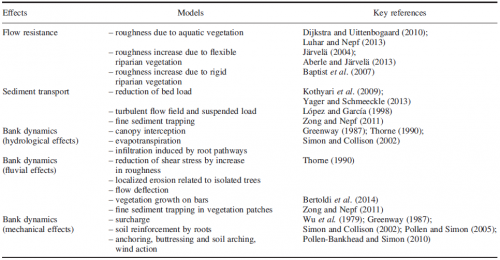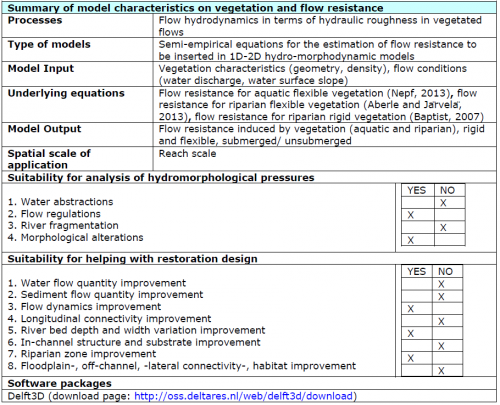Difference between revisions of "Effect of vegetation on hydromorphodynamics"
m |
m |
||
| Line 2: | Line 2: | ||
Vegetation can influence river hydrodynamics by changing the turbulent flow field and the averaged velocity profiles in comparison with those that can be commonly found in | Vegetation can influence river hydrodynamics by changing the turbulent flow field and the averaged velocity profiles in comparison with those that can be commonly found in | ||
| − | non-vegetated flows. In this way, vegetation potentially has a relevant effect on flow resistance, sediment transport and bank dynamics. | + | non-vegetated flows. In this way, vegetation potentially has a relevant effect on flow resistance, sediment transport and bank dynamics (see Table 1). |
| + | |||
| + | [[File:VegHymoInteractions_Hydromorphodynamics.png|center|thumb|500px| Table 1. Models for the effects of vegetation on hydromorphodynamics.]] | ||
| + | |||
| + | ===Vegetation and flow resistance=== | ||
[[File:VegHymoInteractions_FlowRes.png|center|thumb|500px| Table 2. Summary of model characteristics on vegetation and flow resistance.]] | [[File:VegHymoInteractions_FlowRes.png|center|thumb|500px| Table 2. Summary of model characteristics on vegetation and flow resistance.]] | ||
| + | |||
| + | Future research is needed on the following topics: | ||
| + | |||
| + | - effect of different types and growth stages of vegetation (rigid or flexible) and different vegetation densities on flow turbulence structure and secondary currents of a stream; | ||
| + | |||
| + | - effect of plant reconfiguration with increasing flow velocity on drag; | ||
| + | |||
| + | - effect of the spatial distribution of vegetation at a reach scale on flow resistance; | ||
| + | |||
| + | - uprooting, breakage of plants during high-flow conditions may give rise to significant changes in flow resistance between the rising and falling limbs of the hydrograph; | ||
| + | |||
| + | - develop suitable parameterization to characterize different species. | ||
| + | |||
| + | |||
| + | ===Vegetation and bank dynamics=== | ||
Revision as of 19:06, 30 June 2015
Vegetation can influence river hydrodynamics by changing the turbulent flow field and the averaged velocity profiles in comparison with those that can be commonly found in
non-vegetated flows. In this way, vegetation potentially has a relevant effect on flow resistance, sediment transport and bank dynamics (see Table 1).
Vegetation and flow resistance
Future research is needed on the following topics:
- effect of different types and growth stages of vegetation (rigid or flexible) and different vegetation densities on flow turbulence structure and secondary currents of a stream;
- effect of plant reconfiguration with increasing flow velocity on drag;
- effect of the spatial distribution of vegetation at a reach scale on flow resistance;
- uprooting, breakage of plants during high-flow conditions may give rise to significant changes in flow resistance between the rising and falling limbs of the hydrograph;
- develop suitable parameterization to characterize different species.

